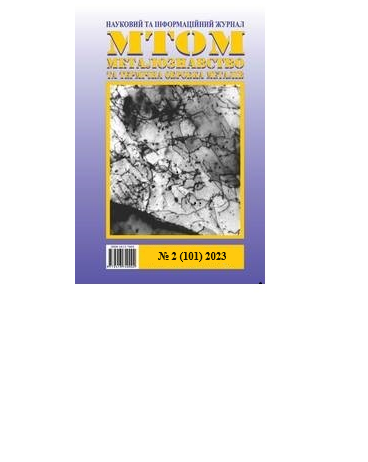IMPROVING THE WEAR RESISTANCE OF ECONOMICALLY ALLOYED STEELS
DOI:
https://doi.org/10.30838/J.PMHTM.2413.040723.29.981Keywords:
metal, alloying, structure, plastic deformation, hardness, crack resistanceAbstract
Problem statement. The influence of wear on the formation of a “white band” in metastable austenitic, martensitic-austenitic and secondary hardening steels of the Cr−Mn−Ti system, additionally alloyed with Mo, B, V, is studied. The influence of structure and phase composition on the wear resistance of economically alloyed metastable and secondary hardening steels is shown. Results. Surfacing of the studied materials was conducted in copper molds with different rates of forced cooling. Metastable austenitic, martensitic-austenitic and secondary hardening steels of the Cr−Mn−Ti system additionally alloyed with Mo, B, V are studied. Additional alloying of these steels with titanium in an amount of 2...5 % contributed to the prevention of spalling along the fusion zone. Near the fusion line there is a base metal zone with a width of 7...15 µm. After testing at the volume temperature of the working part of the specimen ТV = 553…573 K in the contact volumes for deposited metal of the 30Cr2W8V type, broadening of the grain boundaries, shear lines, finer grains compared to the underlying layers are revealed. Outside the zone of plastic deformation, the size of the grains corresponds to their sizes before the start of testing, the grain boundaries are relatively thin. The number and location of carbides observed at X430, X80O magnifications are also similar to the structural characteristics for deposited metal of the 30Cr2W8V. At close values of the contact pressure in the friction pair, the time of formation of a crack of critical length increases with an increase in the effective surface energy γе (including the energy of plastic deformation). Thus, the crack resistance indices (CR, j-integral, δС) and, consequently, the wear resistance of maraging steels are higher than those of metastable and tool steels. Conclusions. The conducted studies confirm the possibility of the formation of a "white band" both in alloys with a high concentration of elements − austenitizers (Mn, C, Ni), and when alloyed with carbide-forming elements with a relatively low affinity for carbon (V, Mo). The crack resistance indices (CR, j-integral, δС) and, consequently, the wear resistance of maraging steels is higher than those of metastable and tool steels.
Downloads
Published
Issue
Section
License
Authors that are published in this journal agree to follow the conditions:
Authors reserve the right to the authorship of his work and cede the right to the journal of first publication of this work on conditions of the license under the Creative Commons Attribution License, which allows others to distribute it freely with the obligatory reference to the author of the original work and the first publication of the work in this journal.

